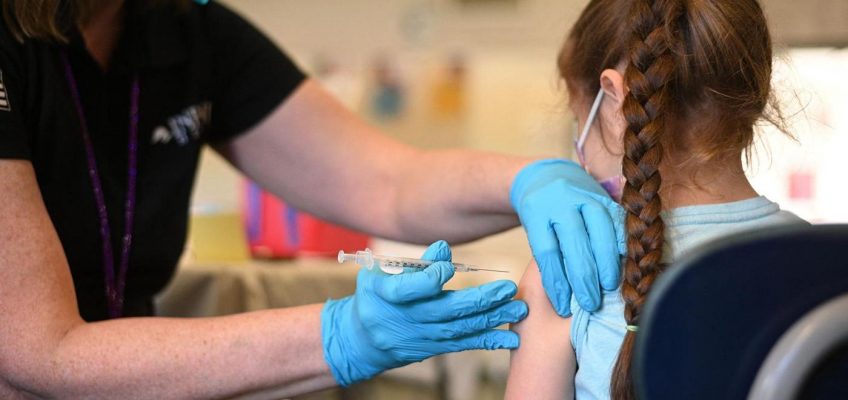By Michelle Andrews, KFF Health News
If you want a COVID-19 shot this fall, will your employer’s health insurance plan pay for it? There’s no clear answer.
Health and Human Services Secretary Robert F. Kennedy Jr., a longtime anti-vaccine activist, has upended the way COVID vaccines are approved and for whom they’re recommended, creating uncertainty where coverage was routine.
Why more women are switching to reusable menstrual products
Ousted FDA vaccine chief Vinay Prasad is returning to the agency
How do you know when it’s the right time to say goodbye to a beloved dog?
Why young Americans dread turning 26: Health insurance chaos
Cannabis poisonings are rising, mostly among kids
Agencies within HHS responsible for spelling out who should get vaccinated aren’t necessarily in sync, issuing seemingly contradictory recommendations based on age or risk factors for serious disease.
But the ambiguity may not affect your coverage, at least this year.
“I think in 2025 it’s highly likely that the employer plans will cover” the COVID vaccines, said Jeff Levin-Scherz, a primary care doctor who is the population health leader for the management consultancy WTW and an assistant professor at Harvard’s T.H. Chan School of Public Health. They’ve already budgeted for it, “and it would be a large administrative effort to try to exclude coverage for those not at increased risk,” he said.
With so much in flux, it’s important to check with your employer or insurer about coverage policies before you roll up your sleeve.
Here’s what we know so far, and what remains unclear.
Q: How have the recommendations changed?
What used to be straightforward is now much murkier. Last year, the Moderna and Pfizer-BioNTech COVID vaccines were recommended for anyone at least 6 months old.
This year, the recommendation by the Centers for Disease Control and Prevention is narrower. Although the vaccines are broadly recommended for adults 19 and older, they are no longer recommended for healthy pregnant people or for healthy children 6 months through 17 years old.
Kennedy announced the changes in a video in May, citing safety risks for young people and pregnant people as justification.
But his claims have been widely disputed by experts in vaccines, pediatrics, and women’s health. An analysis by FactCheck.org found that the secretary “misrepresented scientific research to make unfounded claims about vaccine safety for pregnant people and children.”
In addition, recently announced changes to the vaccine approval framework have further chipped away at eligibility.
Moderna announced July 10 that the FDA had fully approved its Spikevax COVID vaccine— but approval is restricted to adults 65 and older, and for people from 6 months through 64 years old who are at increased risk of developing a serious case of COVID.
Two other COVID vaccines expected to be available this fall, Novavax’s Nuvaxovid and Moderna’s mNexspike, are also restricted. They are approved for people 65 or older and those 12 to 64 who have underlying health conditions that put them at higher risk of developing severe COVID.
Notably, Pfizer’s Comirnaty COVID vaccine is still approved or authorized for people 6 months of age and older without any restrictions based on risk factors for COVID — at least for now. But the FDA could change that at any time, experts said.
Increasing restrictions “is definitely the direction they are moving,” said Jen Kates, a senior vice president at KFF who authored a KFF analysis of vaccine insurance coverage rules. KFF is a health information nonprofit that includes KFF Health News.
HHS did not provide an on-the-record comment for this article.
Q: How might these changes alter my insurance coverage for the vaccine?
That’s the big question, and the answer is uncertain. Without insurance coverage, people could owe hundreds of dollars for the shot.
Most private health plans are required by law to cover recommended vaccines, whether for COVID, measles, or the flu, without charging their members. But that requirement kicks in after the shots are recommended by a federal panel— the Advisory Committee on Immunization Practices — and adopted by the CDC director, according to the KFF analysis. The committee hasn’t yet voted on COVID vaccine recommendations for this fall. Its next meeting is expected to occur in August or September.
Still, employers and insurers can opt to cover the vaccines on their own, as many did before the law required them to do so. But they may require people to pay something for it.
In addition, the narrower recommendations from different HHS agencies might result in some health plans declining to pay for certain categories of people to get certain vaccines, experts said.
“I don’t think an employer or insurer would deny coverage,” Kates said. “But they could say: You have to get this product.”
That could mean a 45-year-old with no underlying health conditions raising their COVID risk might have to get the Pfizer shot rather than the Moderna version if they want their health plan to pay for it, experts said.
In addition, up to 200 million people may qualify for the vaccines because they have health conditions such as asthma or diabetes that increase their risk of severe disease, according to a commentary published by FDA officials in the New England Journal of Medicine.
Health care professionals can help people determine whether they qualify for the shot based on health conditions.
Tina Stow, a spokesperson for AHIP, which represents health plans, said in a statement that plans will continue to follow federal requirements for vaccine coverage.
Q: What are the options for people who are pregnant or have children they want to have vaccinated?
Many parents are confused about getting their kids vaccinated, according to a KFF poll released on Aug. 1. About half said they don’t know whether federal agencies recommend healthy children get the vaccine this fall. Among the other half, more said the vaccine is not recommended than recommended.
Meanwhile, Kennedy’s recommendation that healthy children not get vaccinated has a notable caveat: If a parent wishes a child to get a COVID vaccine and a health care provider recommends it, the child can receive it under the “ shared clinical decision-making” model, and it should be covered without cost sharing.
Some policy experts point out that this is the way care for kids is typically provided anyway.
“Outside of any requirements, vaccines have always been provided through shared decision-making,” said Amanda Jezek, senior vice president of public policy and government relations at the Infectious Diseases Society of America.
There’s no similar allowance for pregnant people. However, even though Kennedy has stated that COVID vaccines are no longer recommended for healthy pregnant people, pregnancy is one of the underlying medical conditions that put people at high risk for getting very sick from COVID, according to the CDC. That could make pregnant people eligible for the shot.
Depending on the stage of someone’s pregnancy, it could be difficult to know whether someone should be denied the shot based on their condition. “This is uncharted territory,” said Sabrina Corlette, co-director of Georgetown University’s Center on Health Insurance Reforms.
Q: How will these changes affect access to the vaccine? Will I still be able to go to the pharmacy for the shot?
“If far fewer are expected to be vaccinated, fewer sites will offer the vaccinations,” Levin-Scherz said. This could be an especially notable hurdle for people looking for pediatric doses of a COVID vaccine, he said.
In addition, pharmacists’ authority to administer vaccines depends on several factors. For example, in some states they can administer shots that have been approved by the FDA, while in others the shots must have been recommended by the ACIP, said Hannah Fish, senior director of strategic initiatives at the National Community Pharmacists Association. Since ACIP hasn’t yet recommended COVID shots for the fall, that could create a speed bump in some states.
“Depending on the rules, you still may be able to get the shot at the pharmacy, but they might have to call the physician to send over a prescription,” Fish said.
Q: What do these changes mean long-term?
It’s impossible to know. But given Kennedy’s vocal skepticism of vaccines and his embrace of long-disproven theories about connections between vaccines and autism, among other things, medical and public health professionals are concerned those views will shape future policies.
“The recommendation changes that were made with respect to children and pregnant women were not necessarily made in good science,” Corlette said.
It’s already a challenge to convince people they need annual COVID shots, and shifting guidelines may make it tougher, some public health experts warn.
“What’s concerning is that this could even further depress the uptake of the COVID vaccines,” Jezek said.
Michelle Andrews: andrews.khn@gmail.com,@mandrews110
©2025 KFF Health News. Distributed by Tribune Content Agency, LLC.



